Gold verification relies on measurable, repeatable testing methods. Each method confirms the metal’s authenticity, fineness, and composition. Professional custodians and dealers apply X-ray fluorescence analysis (XRF) as the primary non-destructive standard. Supporting checks—density, ultrasonic, and conductivity testing—validate surface and internal consistency. This article explains how institutional custodians verify bullion integrity using advanced equipment such as the EDS9800 analyzer and complementary controls that ensure every bar stored or transferred meets LBMA-level requirements.
Professional Gold Verification Methods
Gold verification follows a systematic procedure based on measurable parameters. The objective is to confirm metal authenticity, purity, and structural integrity before it enters or leaves institutional custody. Each test complements the others, creating a layered verification model that eliminates subjectivity.
X-Ray Fluorescence (XRF)
The primary non-destructive method used in professional custody and refining. It identifies the complete elemental composition of a bar within seconds by reading the spectrum of X-rays emitted by excited atoms. XRF delivers accuracy within ±0.03% and applies to solid, liquid, or powder forms.
Density and Volume Test
This method determines whether the bar’s weight corresponds to its expected physical volume. When conducted on high-precision analytical scales, the result exposes counterfeit cores, overlaid surfaces, or alloys with different densities. It is used as a secondary validation after XRF.
Ultrasonic Inspection
Ultrasound waves detect internal cavities, cracks, or foreign inserts invisible to surface analysis. It confirms that the bar’s internal structure is uniform and free of voids or embedded materials.
Electrical Conductivity Testing
Each metal has a specific electrical resistance. Comparing the measured conductivity with gold’s reference value (≈ 4.11×10⁷ S/m) verifies the alloy’s consistency through its entire surface.
Institutional custodians combine these tests depending on the stage: acceptance of a new batch, annual audit, or transfer of ownership between vaults. The process ensures every bar remains traceable, compliant, and certifiable under LBMA Good Delivery standards.
X-Ray Fluorescence Analysis (XRF)
X-Ray Fluorescence is the core analytical method for institutional gold verification. It provides a complete, non-destructive assessment of a bullion’s composition and purity. The technology measures the fluorescent X-rays emitted by atoms when exposed to a controlled X-ray beam. Each element generates a unique energy spectrum, allowing precise identification and quantification of all metals present in the sample. The method delivers repeatable, laboratory-grade results in under a minute and forms the baseline for bullion certification in custody systems.
Principle of XRF Testing
During analysis, a focused X-ray beam excites the atoms in the sample. The detector captures the emitted photons and transforms them into a digital spectrum that reflects the exact elements and their concentrations. For gold, the active energy range of 1.5–30 keV covers all relevant metals including Au, Ag, Cu, Ni, and Pb. The generated report displays purity percentage and alloy composition, which are stored in the custody audit records.
Equipment Used in Institutional Settings
Institutional operators rely on certified analyzers such as the EDS9800 Precious Metal Analyzer equipped with a Si-PIN detector from Amptek (USA). The Si-PIN sensor operates with thermoelectric cooling and energy resolution of 145 ± 5 eV FWHM, ensuring consistent precision across test cycles.
Key specifications:
– Measurement range: ppm to 99.99%
– Accuracy: 0.03%
– Voltage range: 5–50 kV
– Elements analyzed: Na to U (72 elements total)
– Supported sample forms: solid, powder, liquid
– Software: Keyray qualitative and quantitative analysis
– Test chamber size: 310 × 270 × 90 mm
– Weight: 36 kg
The analyzer outputs a certified digital report for each tested bar. These reports form part of the vault’s verification records, supporting full traceability and compliance with LBMA and audit requirements.
These verification reports are archived within the vault’s documentation and referenced in the Proof & Reports section for transparency and audit control.
EDS9800 Technical Parameters

The EDS9800 Precious Metal Analyzer is designed for institutional vaults, laboratories, and refineries that require precise, reproducible gold verification. The unit combines a high-voltage X-ray tube, a Si-PIN detector, and a digital multichannel analyzer to achieve consistent results aligned with LBMA certification standards.
Performance and Measurement Range
The device measures concentrations from trace levels (ppm) to 99.99%. It identifies up to 72 elements — from sodium (Na) to uranium (U) — and supports solid, powder, and liquid samples. This range enables both alloy detection and high-purity gold verification within a single test.
Resolution and Accuracy
Energy resolution is 145 ± 5 eV, ensuring clear separation between adjacent elements such as Au, Ag, and Cu. Analytical precision reaches 0.03%, allowing the detection of minimal deviations in fineness and composition.
Configuration and Operation
– Tube voltage: 5–50 kV
– Chamber size: 310 × 270 × 90 mm
– Test duration: 5–60 seconds
– Built-in HD camera for sample control
– Automatic calibration and digital spectrum processing
Software and Reporting
The Keyray analytical suite performs qualitative and quantitative evaluations and exports certified digital reports for each tested bar. All records can be integrated into custody audit systems and Proof & Reports documentation.
Physical Parameters
Dimensions: 480 × 440 × 368 mm
Weight: 36 kg
The EDS9800 maintains operational stability, fast calibration, and secure data storage, which makes it a preferred XRF analyzer for institutional bullion verification.
Complementary Tests for Verification
While X-Ray Fluorescence remains the primary analysis method, several complementary tests are used to confirm consistency between surface and internal composition. These tests are quick, repeatable, and useful when verifying bars during logistics or random audits.
Density and Volume Test
This method checks whether the bar’s mass corresponds to the expected density of pure gold (19.32 g/cm³). The sample is weighed in air and then in distilled water; the difference determines its true volume. Any deviation indicates the presence of a different metal core or air pockets. This control is applied during reception of bars from refineries or private holders.
Ultrasonic Inspection
High-frequency sound waves penetrate the bar and reflect off internal boundaries. The resulting echo pattern shows whether the material is homogeneous or contains cavities, cracks, or inclusions. Ultrasonic inspection is fully non-destructive and is often used to confirm integrity before sealing or insurance registration.
Electrical Conductivity Test
Each metal conducts electricity at a specific rate. Measuring conductivity and comparing it with gold’s standard reference (≈4.11×10⁷ S/m) confirms the alloy’s uniformity. Portable conductivity meters are frequently used for spot checks in vault environments.
Cross-Validation Procedure
When results from two or more methods align, the bullion is considered verified and cleared for storage, settlement, or transport. Discrepancies trigger a full XRF re-analysis and documentation review. This combined approach provides operational assurance without damaging the bar or affecting its value.
Institutional Custody and Audit Standards
Institutional gold custody requires verifiable testing, documented traceability, and audit-level data retention. Every bullion bar entering or leaving storage must pass a controlled verification process supported by digital certification and independent oversight.
Verification and Recordkeeping
Each test result—XRF spectrum, density measurement, or ultrasonic scan—is stored as part of the vault’s internal ledger. The data forms a verification record that includes sample ID, time, operator, and result summary. These records are periodically audited and reconciled with physical holdings to maintain one-to-one consistency between documentation and inventory.
Independent Audits
External inspection companies such as SGS or Alex Stewart verify random selections of bars using their own calibrated analyzers. The objective is to confirm alignment between institutional test data and independent results. Audit protocols follow LBMA Good Delivery procedures, ensuring standardized reporting across jurisdictions.
Integration with Compliance Frameworks
Verification data is linked with AML and KYC protocols. Each bar’s certification chain connects to its ownership structure, allowing custodians to demonstrate provenance and compliance with FATF and OECD standards. Test results can be referenced in transaction documentation, settlement agreements, or audit reports.
Transparency and Client Assurance
Access to verification reports strengthens client confidence. Institutional clients and regulators can review stored certificates under controlled disclosure. This transparency supports both regulatory compliance and reputational reliability of the custody operator.
Summary Table: Verification Methods and Applications
| Method | Type | Accuracy | Time | Application |
|---|---|---|---|---|
| X-Ray Fluorescence (XRF) | Non-destructive | ±0.03% | 5–60 sec | Primary institutional verification for purity and alloy composition |
| Density and Volume Test | Semi-destructive | ±0.5% | 1–2 min | Secondary validation during acceptance or transfer of bars |
| Ultrasonic Inspection | Non-destructive | qualitative | <1 min | Detecting internal cavities or embedded materials |
| Electrical Conductivity Test | Non-destructive | comparative | <1 min | Surface uniformity and alloy consistency control |
Conclusion
Professional gold verification relies on precise and reproducible testing standards. The combination of XRF analysis, density measurement, ultrasonic inspection, and conductivity testing provides a complete, non-destructive assessment of bullion integrity. Institutional custodians and auditors apply these procedures to ensure that each stored or transferred bar meets LBMA purity requirements and remains traceable throughout its custody lifecycle.

